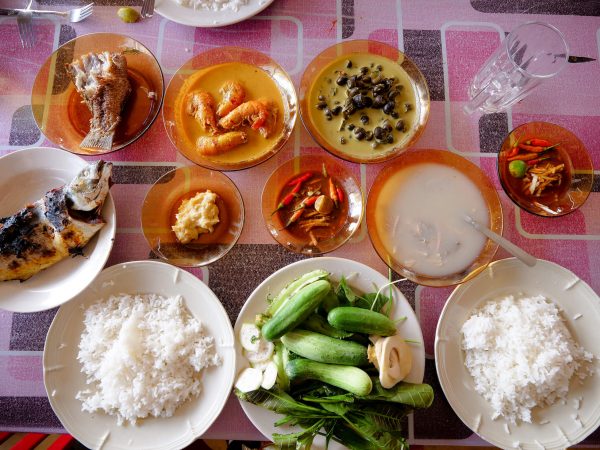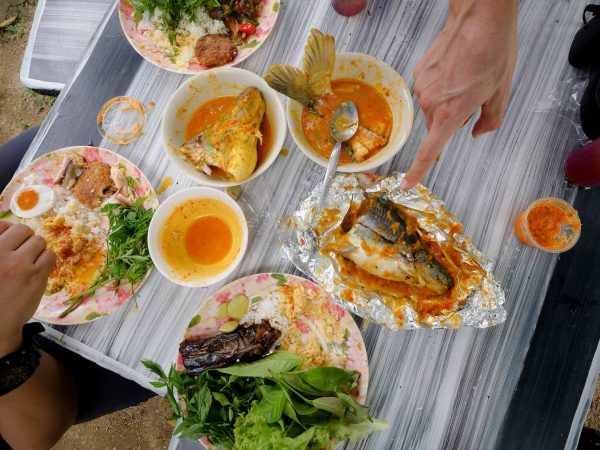
Mention the town name ‘Terangganu’ to anyone from Malaysia, and I can almost guarantee you’ll soon be hearing about two things above any other.
The beautiful beaches of Kuala Terranganu are known across the country, but what’s just as famous is the breakfast special that everyone eats when they’re here, ‘Nasi Dagang,’ in Malay language, and in English, “Trader’s Rice.”

What is ‘Nasi Dagang?’
A perfectly simple combination of fish, curry, and soft Malaysian white rice. It’s one of those meals that can perfectly capture all the parts of its local food culture, giving you a snapshot of life through a single food.
When traveling in Terangganu, the best place we had nasi dagang was in a village called Atas Tol. Besides their amazing plates of Nasi Dagang, this restaurant serves quite a few other types of rice worth trying out as well (details on these and more below).
Finally, don’t forget – this restaurant is so popular with locals in fact, that it often sells out in less than 3 hours! So hurry up and grab a place in line, scroll down for all the details.

Deliciously Local Atmosphere
As with many outdoor restaurants in Asia, there is a unique vibe that you immediately enter into, simply by walking up to the restaurant itself.
I can pretty much guarantee as well that once you are in front of the ordering line, there will be far more things you want to try than what one person can carry on their own.
This is a place where you as the customer will work best if you’re part of a team, so invite some friends for breakfast at Nasi Dagang Atas Tol, and let me help you with some of the ordering strategy right now.
Teamwork is Key to Success
One member of your party could find you a table, also putting in your drink order (the specialty tea*), and another two members could wait in line to order (help each other decide among all the options, and then help carry all the food to your party’s seating).
Take a moment to get your bearings, looking on in awe at the mountains of colorful rice while waiting your turn to order. Besides the various plates with rice, there are also two other deliciously attractive things you have to order here.
The sour and spicy curry with fish (asam pedas) is well worth a try, but also there’s a unique specialty item at this restaurant, which actually comes from the drinks menu instead (more on that in a bit).
Note:* The tea may not sell out, but its important to arrive early for the food. I am sure you will notice how even in under an hour’s time (even in a gentle morning rain!), the line reaches out of the restaurant and down the street. While at 8am you might still be able to have a table to yourself, its best to just try and come here as early as possible.

‘Teh Tarik’ Special – A Honey/Foam Volcano
Before starting in to the details of the meal itself, I have to mention the drink special, as this is usually the first thing that happens in any local-Malay restaurant meal (someone will come to ask you for your drink order).
The standard items of ice tea, hot tea, or sodas are all here, but its the way that they make their tea that is just so totally over the top!
The huge tea is literally a volcano of foam, the cup size can only be compared to a beer-festival stein mug.
The amount of skill required to make these (and make them cleanly) just had me both laughing, and but also so intrigued. The amount of foam is only possible by adding honey to the tea, pouring it from some height, and then whipping it into a frenzy of milky tea delight.
Order at least one special cup of teh tarik, go for the largest size they have, and you could easily even share one cup between two people. Let alone the amount of new followers this photo will get you on Instagram, this monster tea goes great with any spicy food you order as well.
Get exclusive updates
Enter your email and I’ll send you the best travel food content.

Nasi Dagang – “Trader’s Rice”
The tea is definitely a fun item, but now its time to get down to business – here’s a few details about Nasi Dagang.
The words ‘Nasi Dagang’ literally mean ‘Trader’s Rice’ (the traders who were also travelers), and observing both the ingredients and the way they serve it, you can see why.
The Jawi people, native to this area, are the ones who first named this dish. They live entirely along the seaside, they rely on what the ocean provides, and therefore this ready-made travel meal just first their traditional lifestyles perfectly.
Jawi Language and Script
In Jawi language by the way, the name of the food looks like this – ناسي داڬڠ, ‘Nasi Dagang’ “Trader’s Rice.”
Over time, this dish has been somewhat widely distributed around Malaysia, but it originates with the people of the North-Eastern seaside areas, like the town of Terangganu.
Note: Nowadays, the seaside people are divided between two countries in fact, between the Southern-most seaside areas of Thailand, and the Kelantan and Terangganu States in Malaysia.

Perfecting the Glutinous + White Rice Ratios
The secret here is all in the rice, and you have to respect those ratios.
Getting the perfect consistency of rice for this food not only takes years of experience, but also a true understanding of every single ingredient you’re working with.
The type of rice, the size of the grain, the length of cooking time, and the types of cooking tools all play a part in preparing rice to be this soft.
Finally, an added layer of flavor comes from fine shreds of mature coconut flesh – they’re mixing these directly in with the rice!

Speedy Service, and Fresh Banana Leaves
We will get to the details of each dish on its own in a minute, but as I approached the counter to order, I just couldn’t believe both the speed, but also the consistency required, to create this meal right every time.
It is just perfection, and honestly its just fun to watch it happen.
Wrapping the rice in a banana leaf, the signature aspects of this dish include both the ingredients piling on top of the leaf-plate, and the way it is closed up, folded, and ready to travel (the tables were full, and most people were getting take away by this point).
Don’t forget, they are selling two more versions of fish over rice as well, the first being ‘nasi kunyit,’ which is glutinous rice made with turmeric, and then Malaysia’s national dish, ‘nasi lemak,’ which uses rice softened and fragranced with coconut milk.
Order at least one plate of Nasi Dagang per person, maybe choose another type of rice dish to try as well, and then finally you absolutely need at least a bowl of the asam pedas fish curry soup.

Simply a Mind-Blowing Texture
I can easily say this dish provides one of the softest bites of food I have ever had in my life.
The simplicity required to create such an effect was stunning, I could not believe such texture was possible, and it is coming just from the rice alone!
The secret here lies in the perfect ratio of regular white rice to glutinous white rice (in case you’re wondering, our chef friend guessed it as around 70-30 white rice to glutinous, but many recipes I’ve seen actually include three different kinds of rice in the same rice recipe!).
Somehow the glutinous rice was no longer sticky at all, but just gloriously chewy and soft. It was like a hundred tiny cushions all bouncing between the grains of slightly dry, long-grain white rice.
The thin ocean fish they serve alongside this is great, straight from the fryer, simple and delicious.
Break through the fish’s crunchy outer skin, and dig out a juicy chunk of white meat. Add on a large spoon of sambal to your Nasi Dagang rice, and massage it in a bit with your fingers.
Munch an entire chili before the fish-rice combination bite, and enjoy as the heat hits the pillowy-rice softness, igniting endless happy smiles.

Nasi Pulut Kuning (Glutinous Rice with Turmeric)
Although it has a very recognizable and strong golden color, the flavor of turmeric in the rice is just barely noticeable. Only the slightest peppery, dry ginger aroma comes through, and the rice itself just feels like the sticky rice common throughout South East Asia.
Its the texture that makes this dish special – the golden rice is made using only glutinous rice. Very sticky, yet individual grains of rice can still be separated.
This rice is just perfect for eating with the fingers, as it works so well to soak up curry soup flavor. You can even form the sticky rice in a concave shape, picking up other items of food with your yellow, edible spoon.

Asam Pedas
The version of asam pedas here at Nasi Dagang Atas Tol is one that’s sour, spicy, and as a bonus, comes full of several entire multi-color chili peppers. A toast is in order, a salute to the chef for this creation.
Asam Pedas is truly a signature flavor of the Malay peninsula, this food combines curry paste with local chili peppers and sourness from local fruits (tamarind and bilimbi), and works perfectly with whatever meat ingredient is available that day.
The meat they have chosen to use here is fish, its dark in color, flaky and firm, probably a type of tuna or local mackerel. The meat is firm enough that you can flake it apart and mix it into your rice, adding in a bit of acar or sambal belecan into every bite.
Take some of the curry soup in a spoon, and dump it over your next bite of rice. With your fingers, grab up a portion of fish head, and try to separate a nice, slimy bite. Grab a crunchy peanut, maybe one of the tiny salty fishes, and finally add some sourness to balance it out with a slice of the acar pickle cucumber as well.
Take this bite, then follow it with the rice… I am dreaming of this meal again right now.
Note: This dish is even more popular on Malaysia’s South East coast, specifically at the incredible restaurant Asam Pedas Pakman (if you’re in Melaka, you absolutely can’t miss this restuarant).

Mee Goreng (Fried Egg Noodles)
Finally, although its nothing more than thick, hand-rolled noodles fried in mature soy sauce, the mee goreng here is a delicious conclusion to any meal.
More than any cheesecake or pie, I could easily think of this plate of sweet and salty fried noodles as a guilty dessert treat. The noodles smell amazing, almost like brown sugar, which comes from the carmelization of sauces at the bottom of each batch from the wok pan.

Keropok Lekor
A snack that actually originates right here in Terangganu, is the keropok lekor fish sausage.
There are two famous versions, some of them even now exporting to South East and East Asia as well, but locals in Eastern Malaysia still enjoy this food daily.
One version is deep fried, the flesh cut thinly to create almost a fishy and very thick chip. The second, a thicker sausage like the one at Nasi Dagang Atas Tol.
These are quite a plain taste, but its the texture that I find very interesting – the outside is crispy, the inside slightly chewy, and when eating these with rice and sambal, you can definitely get full in a hurry.
(We were fortunate enough to have someone offer to take us to a small and locally producing factory, you can see the video of that day here (link)).
The Restaurant Experience
Searching for this restaurant online, you may notice that the posted hours are 6:30am to Noon.
I was mentioning this to my friend, while we were all hurrying to get a place in line this morning (around 8am on a Wednesday morning).
“Ha! Noon, they say!?” he replies, “by 10am there won’t be a single thing left!”
(Don’t risk it, get there early, and enjoy one of the better meals in all of Terangganu)

Name: Nasi Dagang Atas Tol
Location: (Google Maps) https://goo.gl/maps/TzCv1CdGmSE2
Hours: 6:30am to 11:30am
Price: Each plate of Nasi Dagang costs 4RM (US$0.98)
Get exclusive updates
Enter your email and I'll send you the best travel food content.



